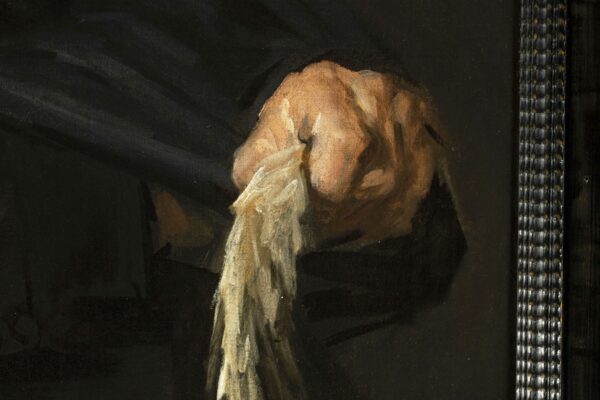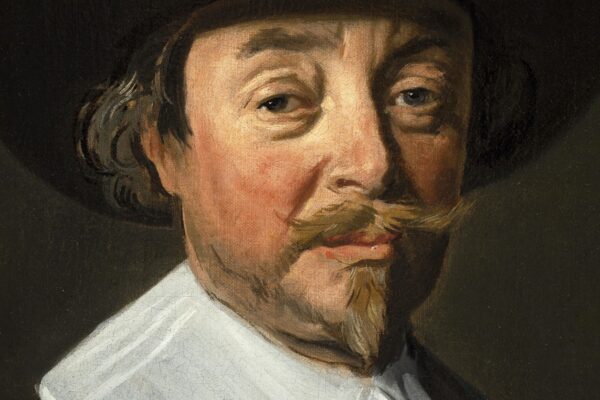“Portrait of a Gentleman, in black, wearing a hat” (‘The Hotinov Hals’)
Oil on canvas: 88 x 65 cm
to be dated 1644/45
"*" indicates required fields
Notes
This important portrait was painted by the most famous portrait painter of the Golden Age and one of the greatest names in art history. Indeed, it has an intriguing history. Frans Hals (1582/83-1666) is one of the most important Dutch masters of the seventeenth century. The Haarlem painter became well known for his striking portraits, colorful genre paintings and large civic guard portraits, but also through the enormous influence he had on 19th and early 20th century artists as well as on the development of modern painting in general.
To begin with, it is the most newly discovered painting by the great Haarlem master. The Hotinov’s, from Muiderberg, presented the painting on the 13th May 1964 to the director of the museum in Haarlem, which is, in fact, named after the world-famous painter himself, the Frans Hals Museum.
The Hotinov’s bought the portrait at a small auction the previous year in the sales room of J.C. Derksen in Arnhem for Dfl. 40,25 (equivalent of $7 then). They had the painting restored by a coarse and rogue restorer, who after cleaning concluded that he was dealing with a Frans Hals. He then decided to paint over the canvas in such a way that it was no longer visible that it was an original, with the apparent intention of purchasing the portrait from the Hotinov’s, in the hope that the painting would then, after removal of the overpaints, be able to resell at a large profit. The Hotinov’s, however, had been warned in the meantime and did not accept the proposal. They then entrusted the painting to the care of an honest, but nonetheless rather incompetent restorer, to remove the overpainting.
In the meantime, a German buyer presented herself. She stipulated two conditions, however, (1) that the painting be cleaned by the restorer of the Frans Hals Museum itself, and (2) that the most prominent Frans Hals expert, Prof. Seymour Slive, give his verdict.
Both conditions were met. The cleaning/restoration provided full confirmation of the experts: that the painting was indeed a real Frans Hals. Removal of the discouraging layer of paint revived the portrayed person and allowed Hals’s authentic style of painting to come into its own again.
The contours were redefined against the background that had become transparent, and the added facial hair disappeared completely, restoring the balance of the head. The previously stiff and chalky collar also regained its transparency, and the shape of the right shoulder became visible again. Moreover, the general recognition of the authorship was finally shared by Professor Seymour Slive of Harvard University, Cambridge, Mass. USA, whose voice as an authority on Frans Hals carries great weight. As Seymour Slive noted, “the removal of the repaint has not damaged the painted surface”.
This is a mature work by Frans Hals, painted circa 1644-5, a dating with which both Seymour Slive and Claus Grimm concur. Slive compares the treatment of the head and collar and the overall tonality with Hals’ undated Portrait of a Man in Edinburgh, National Gallery of Scotland, which he in turn relates to works dated 1643 and 1644, and dates it between 1643 and 1645.
The face also shows that Frans Hals is at the height of his talents and skill. The individual character of the person portrayed is expressed in a phenomenal way. As is so often the case in his portraits, Hals ‘mercilessly’ illustrates the essence and unique character of his client: in this case, for example, we see the realistic and honest expression of a distinguished Haarlem citizen.
Hals achieves this through the rather traditional position of his model, and the tried and tested portrait conventions (that he used more often during this time), breathing new life and pictorial effect, which he accomplishes with a limited palette and unparalleled technique.
In ‘Oud Holland’ nr. 4 from 1965 (see Illustration 8), the former director of the Frans Hals Museum Mr. H.P. Baard wrote:
“even if at the moment we must sustain our hopes that through some lucky find in old records the identity of the person portrayed by Hals may be released from his anonymity, the main thing is that there can now be complete satisfaction about a surprising discovery through which Hals‘ oeuvre has been enriched by a work of great quality”.
Hals had a strong reputation as an artist who painted spontaneously, immediately and with great speed: ‘Frans Hals breathed as easily as he painted’, it was said of him. There are hardly any drawings or preliminary studies by him. Up until about 1630, he rarely used his well-known broad and loose brushstrokes. It was only until after this period that he began applying his infamous and characteristic techniques to hands and faces, or for lace work and multi-coloured costumes. In the last phase of his life (from ca. 1640), to which this portrait belongs, Hals also used this painting style for the faces of the more official portraits.
A very rare occassion
Only 131 paintings directly executed by Hals are known; Compared to other great artists such as Bartholomaeus van der Helst and Rembrandt, this is a relatively small number. Most paintings of this group are held in public collections and Museums and only about 20 or so are still in private hands like this current picture.
The latest catalogue raisonné from 2024 with extensive research done by Claus Grimm in conjunction with the RKD Netherlands Institute for Art History is divided according to the type and the degree of involvement of Hals, and of other hands respectively.
Within the corpus of original paintings there are different categories, depending on the degree of the master’s involvement. Category A1 comprises paintings that are autograph work by Hals and that were either executed only by him, or reworked by him throughout (131). The paintings in category A2 are partly autograph and created in collaboration with other masters from outside of Hals’s workshop (14). Category A3 comprises paintings that were partly created by the master and partly by assistants (67), while category A4 covers creations by the workshop which do not show Hals’s ‘handwriting’, yet which were made on the basis of his design and preparatory sketches (131). The latter category is subdivided in three groups: A4.1 for small pictures painted after Hals’s templates for engravings (18), A4.2 for genre paintings (59), and A4.3 for portraits (55).
This current portrait is numbered A1.110 and is thus one of the very rare portraits executed entirely by the master himself that is still in private collection.
Provenance
- Hofman, Zutphen, Holland, by around 1930;
- By whom sold to M.C. van Mourik, Huize Midwijk, Vorden in around 1930;
- By marriage to his widow M.C. van Mourik-Spoor, Huize Midwijk, Vorden;
- By whom sold in 1962 to Th. J. van Beukering, Arnhem;
- By whom entered for sale at Arnhem, J.C. Derksen, 19 July 1963, but sold outside of the auction;
- Whence acquired, on 19 July 1963, by Mr and Mrs Leonid Hotinov, Muiderberg, for 40 florins and 25 stuivers;
- By whom sold to Mrs Gisela Kemperdick, Kaster, Amt Bedburg near Cologne;
- By whom sold, London, Christie’s, 26 November 1965, lot 70, for £73,500;
- Where acquired by Walter Goetz for the Kimbell Art Foundation, Fort Worth;
- Kimbell Art Museum, Fort Worth, Texas (inv. AP 65.2);
- By whom de-accessioned by private sale in 1993;
- Private collection, England;
- With Johnny van Haeften, London, from whom acquired by a
- a private Dutch collector, in 2004;
- Sotheby’s, London 2010;
- with Douwes Fine Art, Amsterdam 2011;
- private collection, The Netherlands.
Exhibition
- Haarlem, Frans Hals Museum, on loan, April – May 1965.
- TEFAF ‘The European Fine Art Fair’, Maastricht, 18 – 27 March 2011;
- ‘Uit de kunst!, 100 jaar Nederlandse kunsthandel’, Het Loo Palace, Apeldoorn, november 2011;
- ‘Artist IQ 500 jaar Kunst’, Beurs van Berlage, Amsterdam, 17 Jan – 1 Feb 2015.
Literature
- G.C. Vieten, “Ehrenrettung für Frans Hals,” in Die Weltkunst, 34, 1964, no. 23, 15 November, p. 990;
- G.C. Vieten, “Der unbekannte von Haarlem,” in Die Weltkunst, 35, 1965, no. 10, 15 May, p. 403, reproduced;
- H.P. Baard, “Wedergeboorte en lotgevallen van de “Hotinov-Hals”‘, in Oud Holland, 80, 1965, pp. 211-19;
- Slive, Frans Hals, vol. II, London 1970, reproduced fig. 241, vol. III, London 1974, pp. 80-81, no. 158, reproduced fig. 37 (before restoration);
- Grimm, Frans Hals: Entwicklung, Werkanalyse, Gesamtkatalog, Berlin 1972, pp. 105 & 204, no. 123, reproduced figs. 135 & 141;
- Museum Catalogue, Kimbell Art Museum. Catalogue of the Collection, Fort Worth 1972, pp. 55-56, reproduced;
- Grimm & E.C. Montagni, L’opera completa di Frans Hals, Milan 1974, p. 104, no. 160, reproduced p. 103;
- Museum Catalogue, Kimbell Art Museum. Handbook of the Collection, Fort Worth 1981, p. 58, reproduced;
- P.C. Sutton, A Guide to Dutch Art in America, Grand Rapids & Kampen 1986, pp. 91-2;
- In Pursuit of Quality. The Kimbell Art Museum. An Illustrated History of the Art and Architecture, Fort Worth 1987, p. 212, reproduced;
- Grimm, Frans Hals. Das Gesamtwerk, Stuttgart & Zürich 1989, p. 281, no. 124, reproduced;
- C. Grimm, Frans Hals. The Complete Work, New York 1990, p. 287, no. 124, reproduced
- to be published in RKD Study: Claus Grimm, ‘Frans Hals and his workshop’, 2023-2024, no. A1.110







